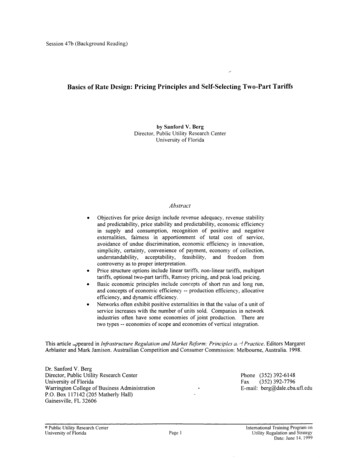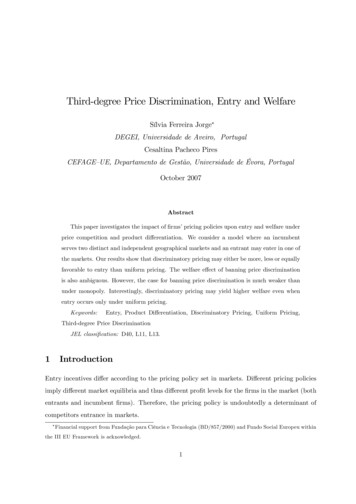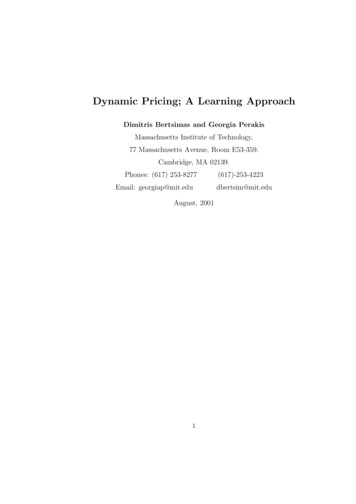
Transcription
Session 47b (Background Reading)Basics of Rate Design: Pricing Principles and Self-Selecting Two-Part Tariffsby Sanford V. BergDirector, Public Utility Research CenterUniversity of FloridaAbstract Objectives for price design include revenue adequacy, revenue stabilityand predictability, price stability and predictability, economic efficiencyin supply and consumption, recognition of positive and negativeexternalities, fairness in apportionment of total cost of service,avoidance of undue discrimination, economic efficiency in innovation,simplicity, certainty, convenience of payment, economy of collection,understandability, acceptability, feasibility, and freedom fromcontroversy as to proper interpretation.Price structure options include linear tariffs, non-linear tariffs, multiparttariffs, optional two-part tariffs, Ramsey pricing, and peak load pricing.Basic economic principles include concepts of short run and long run,and concepts of economic efficiency -- production efficiency, allocativeefficiency, and dynamic efficiency.Networks often exhibit positive externalities in that the value of a unit ofservice increases with the number of units sold. Companies in networkindustries often have some economies of joint production. There aretwo types -- economies of scope and economies of vertical integration.This article "ppeared in Infrastructure Regulation and Market Reform: Principles a. ,1 Practice. Editors MargaretArblaster and Mark Jamison. Austrailian Competition and Consumer Commission: Melbourne, Australia. 1998.Dr. Sanford V. BergDirector, Public Utility Research CenterUniversity of FloridaWarrington College of Business AdministrationP.O. Box 117142 (205 Matherly Hall)Gainesville, FL 32606Public Utility Research CenterUniversity of FloridaPhone (352) 392-6148Fax(352) 392-7796E-mail: berg@dale.cba.ufl.edu@Page IInternational Training Program onUtility Regulation and StrategyDate: June 14. 1999
Session 51 (Background Reading)Basics of Rate Design: Pricing Principles andSelf-Sele tingTwo-PartTariffsby Sanford V. BergDirector, Public Utility Research CenterUniversity of FloridaThis overview of the basics of rate design in network industries should be read in conjunction with Mark Jamison's(1997) more comprehensive write-up on rate structure. After describing some of the key concepts, we will examinein some detail the rationale behind rate structures that can reflect incremental costs, while still facilitating therecovery of fixed (often joint or common) costs. In competitive industries, overhead or joint costs cannot be"allocated;" they must be "recovered where they can" based on a rate-making philosophy that recognizes this fact.The second part of this paper describes the basic issues and problems of recovering these costs, with specialreference to electric utilities in an increasingly competitive environment.One approach is to adopt Two-Part Pricing schemes, one part reflecting capacity and distribution system charges andthe other based on on-peak and off-peak energy costs. This approach eliminates distortions caused by average costpricing, enabling customers to face the true costs of additional electricity purchases. Retail utilities have incentivesto create contracts with their suppliers that better reflect cost-causation. Integrated utilities could base the capacityand system charge price on a Historical Customer Baseline (HCB), so that such customers continue to contribute a"share" of overhead (or non-usage sensitive) costs. On-peak and off-peak prices are then set at incremental cost.Cost recovery is achieved via appropriate calculation of the monthly fee. Of course, if competitors can offer a better"deal," the HCB would need to be modified to minimize uneconomic bypass of the incumbent.A second approach focuses on differential demand elasticities. Customers who have demands which are insensitiveto price have few alternative sources of supply. Higher prices to these "inelastic" demanders represent one way toobtain revenues that can be applied to shared resources (overhead costs). While Ramsey Pricing (the technical termfor this approach) raises political issues, the outcome may be preferable to losing those customers who facecompetitive alternatives (including co-generation)}. But first, we need to review the basics of rate design.Cost Causation and Price SignalsWhen considering efficient pricing and investment, if neoclassical economists agree on one point, it is the following:rate design matters2 A strong case can be made for regulators to allow some discretion in rate design, since frrmshave far greater information on cost structures and demand patterns than is available to the regulatory. When costallocation manuals substitute for estimates of forward-looking incremental costs, inefficiencies arise. In recognitionof the important role of price signals, a wide range of rate designs has been analyzed. The following represents apartial listing of the topics addressed in the literature on optimum pricing and capacity:. Marginal cost pricing. The allocative efficiency consequences of such pricing are well known. For example, the;lnancial viability of the firm may require a subsidy, or more complico':ed rate designs (such as multipart pricing).Furthermore, short run and long run marginal costs will differ--so while the former serve as the standard for pricingdecisions, the latter are relevant for comparing alternative investment patterns--as when alternative providers havedifferent production technologies.} See Stephen 1. Brown and David S. Sibley, The Theory of Public Utility Pricing ('Cambridge University Press) 1986, for a thorough discussionof Ramsey pricing.2 Some of the material in this section originally appeared in Berg and Tschirhart (1995) pp. 310-330. For an excellent survey of rate design. seeArnold, et.al. (1995).Public Utility Research CenterUniversity of Florida Page 2International Training Program onUtility Regulation and StrategyDate: June 14. 1999
· Cross subsidization and regulation as taxation. Cross subsidization can be a deliberate regulatory objective assome customers cover the incremental costs of serving favored customers. Alternatively, it can stem frominappropriate allocations of fixed or variable costs. A related concern is transfer pricing which increases thereported costs of the regulated frrm. This device might be used to shift profits from the regulated firm to anunregulated subsidiary. Such shifting raises a dilemma, because when regl!1ators mandate complete separationamong business units in response, the firms can lose economies of scope. The result is higher costs.· Discriminatory pricing and demand separation. The ability to separate markets and prevent resale is facilitated bycustomers being hooked up to utility distribution systems. Since consumers with inelastic demanders are often theones regulators are trying to protect from monopoly power, commissions often will overlay cost allocationregulation upon rate level regulation--preventing "undue" discrimination.· Ramsey pricing. If the firm can identify different customer groups and charge different prices to the variouscustomer classes, Ramsey pricing can be utilized to minimize economic misallocations. However, such a pricingpolicy (charging more to those with relatively inelastic demands) might still be viewed as unduly discriminatory,even though the firm does not realize excess profit. Citizens might prefer other price configurations for themultiproduct natural monopolist. Furthermore, there is no guarantee that Ramsey prices are sustainable in the longrun: some coalition of customers could end up paying more than the stand-alone costs of serving them--leading toself production and the loss of their business. The technical literature on Ramsey pricing is ably summarized inSheshinski (1986) and Braeutigam (1989). Mitchell and Vogelsang (1991) apply much of this literature totelecommunications pricing.· Predatory pricing and market dominance. If high cost suppliers are driven from the market due to entry by amultiproduct natural monopoly, resource allocation is improved. However, these suppliers may claim predatorypricing if the output is produced by an unregulated subsidiary or by the regulated firm. Producers of substituteproducts could argue that revenues from the utility's captive consumer groups (or regulated products) cover costsassociated with products subject to competition. However, one ought not accept fully-distributed costs as indicatorsof subsidization. Furthermore, when a group of firms is under industry-wide regulation and when price is based onindustry average costs, the presence of high cost firms could increase the profits of efficient suppliers (Daughety1984). The removal of such cost-based pricing would reduce prices and lead to bankruptcy or consolidation ofinefficient firms. Such a development would again bring forth charges of predation, but these charges would begroundless.· Cost allocation regulation. A multiproduct firm is charged with allocating its total costs, including common costs,over its various products in an effort to ensure that revenue from the sale of each product covers its allocated cost(Braeutigam, 1980). This area may be one of the more under-analyzed in the field of regulatory economics.Regulators have often viewed fully-distributed cost allocations as techniques for ensuring that customer groups arenot unfairly burdened with shared costs. Besides leading to potentially undesirable prices and cross subsidies, thereis the danger that separations procedures and cost allocation manuals may foster an unwarranted feeling ofaccomplishment among regulators. Sweeney (1982) finds that output-based allocation schemes can yield perverseresults: we end up with prices such that one or more of them can be lowered--improving welfare without decreasingthe monopolist's profit. In addition, we can have relatively high prices in unregulated markets. Finally, Cabe (1988)illustrates that any output vector can be achieved by some fully-distributed cost method.· Peak load pricing and intertemporal patterns ofdemand. This literature has a rich history. The early contributionsby Boiteux (1960) and Steiner (1957) stimulated analyses of intertemporal demand patterns. The productiontechnology (involving fixed or variable coefficients and with a.lld without scale economies) drew upon actualengineering studies of cost structures. Diverse technologies, interdependent demands, selection of rating periodsand other issues were addressed, as economists began to characterize realistic demand and cost conditions. Ratedesign in such situations must take these factors into account. Sweeney explains these results by noting that becauseregulated products are permitted to return a "fair return" on shared input, output reductions in unregulated marketsallow more of the common cost to be shifted to regulated markets. As a result, greater profits are earned in theseregulated markets. In one sense, these results may appeal to re ulators. The prices are high in the unregulatedmarkets, thereby quelling fears of cross subsidies from the regu!ated markets. Also, competitors in the unregulatedmarkets would be pleased, since the monopolist is apparently not relying on profits from the regulated markets topredatory price in their markets. In the long run, the monopolist's prices could be undercut in at least some of thePublic Utilitv Research CenterUniversity of Florida Page 3International Training Program onUtility Regulation and StrategyDate: June 14, 1999
unregulated markets, perhaps even driving the monopolist out entirely. The advantages of natural monopolyproduction for multiple markets are then lost, and the regulator's optimism regarding FOC procedures proves shortlived. Pricing with random demand and supply. The intertemporal issues noted ab.,9ve have also been addressed in thecontext of uncertainty. Consumers value reliability of service which will be affected by the interaction of price(announced in advance) and uncertain demands (driven by weather, seasonal conditions, and hourly factors) andproduction capabilities (related to unplanned outages).Nonlinear pricing and interpersonal patterns ofdemand. Whether one is considering pricing entry and rides in anamusement park or access to and usage of a telephone system, multipart pricing offers a viable option for enhancingrevenues. Much of the literature on multipart pricing and nonlinear outlay schedules is surveyed by Brown andSibley (1986). The pattern of individual demands proves to be important for the development of frrst and secondbest rate designs involving fees and usage charges.oSustainable pricing. Faulhaber (1975) showed that a natural monopolist was not necessarily immune to entryunder certain cost structures. This insight raises a dilemma for regulators and implies significant informationrequirements for optimal pricing decisions. A related issue is the role of the incumbent firm as the supplier of lastresort (Weisman, 1988).o. Quality of service. Service quality also raises a number of important issues for analysts. The quality levelprovided under competition, monopoly, or regulation has received substantial attention. In practice, regulators tendto utilize pass/fail standards. While such standards are clear and precise, problems arise in using them to monitorand reward quality. For example, by evaluating performance relative to a pass/fail cut-off, distinctions amongvarious levels of sub-standard and super-standard performance are ignored: utilities have little incentive to exceedtargets. In addition, the targets themselves are often somewhat arbitrary, having arisen from a chaotic processreflecting historical engineering capabilities, political pressures, and administrative happenstance. Consumervaluations of different quality dimensions and firm knowledge of emerging technological opportunities are notlikely to be reflected in current pass-fail standards.Recovery of Joint Costs in a Competitive EnvironmentThe brief overview of rate design concepts provides a foundation for addressing the recovery of joint costs in acompetitive environment. Electric utility managers understand that the industry has rapidly moved from localmonopolies to one that is customer-driven. Co-generation and competition via open transmission policies havedisrupted traditional pricing arrangements. Cost allocation manuals are becoming increasingly irrelevant as theelectricity industry becomes more competitive. This section outlines two approaches which enable the recovery ofjoint costs in a competitive environment. One approach involves utilizing Two-Part Pricing schemes, so thecustomers' share of joint costs is less dependent on total consumption. Such rate designs better reflect cost causationon the margin, while permitting recovery of some fixed costs. Another approach involves lower prices to thosedemanders with alternative sources of supply. Although higher prices to inelastic demanders -- those withoutoptions -- raises some tough political issues, those customers would be even worse off if business and other largecustomers abandoned their traditional suppliers. Thus, Ramsey Pricing involves price discrimination (or pricedifferentiation, if the former term seems too value-loaded).Electric Utilities are going to have to generate value for customers by devising new rate designs which create winwin opportunities. Both Two-Part Pricing (using Historical Customer Baselines) and Ramsey Pricing representinnovative ways to recover joint costs. First, some background material needs to be reviewed.Background: Recent TrendsIn the U.S., the electric energy industry lags behind telecommWlications in terms of competitive pressures, butregulatory roadblocks to competition at various stages of production have been demolished in a number of countries.In the U.S., since most regulatory authority is vested in the states, the system is conducive to regulatory innovation.Public Utility Research CenterUniversity of Florida Page 4International Training Program onUtility Regulation and StrategyDate: June 1-l. 1999
The process of evolution within the American regulatory environment is driven by wider adoption of approachesthat have been successfully implemented in a few states. This heterogeneity also results in confusing and sometimescontradictory state regulatory regimes. For investor-owned utilities, rate of return (ROR) on rate base regulation hascharacterized the industry, with customer-class cost allocation rules, fuel adjustment clauses, and managementaudits further constraining prices and revenue requirements. For municipals an;! other publicly-owned utilities, costallocations have tended to establish revenue targets across customer classes, with prices reflecting some type of fullydistributed cost.The evolution of US regulatory policy illustrates changing attitudes towards the efficacy of competition inpromoting efficiency. At the same time, concern over environmental impacts has placed new objectives onto theregulatory agenda; the new instruments for achieving new objectives raise complex issues. For example, statemandated conservation programs will come under pressure, especially if retail wheeling is widely adopted. Thecosts of DSM programs cannot be spread across a set of captive customers: larger customers, especially, will facechoices they are currently denied. Most industry observers expect vertical disintegration and partial deregulation tocontinue. The implications for incumbents are mixed. Non-generating distribution systems are in a position to"shop around." Integrated suppliers are likely to face revenue erosion as competition becomes more widespread.The interests of various constituencies are tough to reconcile. The National Association of Regulatory UtilityCommissioners (NARUC) wants to preserve the flexibility of states so that state PSCs can craft policies which fittheir unique circumstances. Groups benefiting from current state regulations want to retain "local" control-preserving their relative benefits. The American Public Power Association (APPA) supports the agenda ofmunicipally-owned utilities. The National Rural Electric Cooperative Association (NRECA) seeks retention of rulesthat assist rural electric utilities. At the national level, FERC oversees wholesale and transmission issues, while statePSC regulate facility additions and retail rates. The conflicting pressures and overlapping jurisdictions makecoherent policy development very difficult.One conclusion is clear, price signals are being given greater prominence, although policymakers (both regulatorsand municipal authorities) tend to avoid dramatic changes in rate design for fear of political repercussions.Historically, prices for different customer groups were set using cost allocation procedures.Revenue"requirements" were determined from top down--with minimal attention to incremental cost causation. Today,prices and incumbent investments in generating capacity are constrained by competitive alternatives--induced byregulatory promotion of co-generation and independent power producers (IPPs). Thus, in non-core (industrial)markets, customers have alternatives in the form of self-generation or geographic re-Iocation. When revenues fromsome customer groups fall short of "allocated" costs, utilities experience financial pressures. Core (residential)customers can flex their political muscle to avoid rate increases, resulting in realized returns becoming a residual.For IOUs, rates of return were never "guaranteed"; rather, they were "allowed". However, returns have becomemore problematic in a world where traditional entry restrictions are being set aside. These developments willconstrain municipal utilities and REAs as well.Deregulation and emerging competition will tend to promote least cost supply. Some vertically-integrated suppliershave low incremental costs relative to their potential competitors. If they have high average (embedded) costs, theywill come under financial pressure. IOUs will find cut dividends. For municipal utilities, it may be difficult to meetinterest coverage or continue to transfer traditional amounts to city coffers. However, low incremental costsuppliers are still going to be able to compete for business. High incremental cost suppliers will be in trouble in acompetitive environment. "Stranded investment" is just another word for generating capacity that cannot yield cashflows for covering fixed costs when electricity markets are opened up. Book value exceeds market value ofcapacity.National regulatory policy has leaned in the direction of pro-competitive market structures at the generation level.Since PURPA's promotion of co-generation via qualifying facilities (QFs) and of IPPs, national policy has continuedto view wholesale competition as stimulating real savings for final demanders. Non-utilities supply almost tenpercent of all electric power in the U.S., and between 1991 and 1994, they built over half of all new capacity. TheEnergy Act of 1992 created Exempt Wholesale Generators (EWGs) as another vehicle for introducing new playersinto the game. Since access to transmission can be mandated bY,FERC, terms and conditions of transmission accesshas become a significant regulatory issue. Ultimately, large buyers may gain access to alternative suppliers via thePublic Utility Research CenterUniversity of Florida Page 5International Training Program onUtility Regulation and StrategyDate: June 14. 1999
transmISSIon network: retail markets will change dramatically. While the problems for network coordination,construction, and reliability are substantial, the trend seems irreversible.In 1994, both California and Michigan established programs designed to promote more competition. Largercustomers who have the ability to shop will tend to pay market-based (in Jemental cost) prices, leaving core(residential) customers at risk for covering the costs associated with higher cost capacity. The fear of so-called"stranded investment" blunts efforts to open up local markets. "Securitization" represents one mechanism forpermitting some cost-recovery by high-cost firms. The short run impacts of competition differ from the long runimpacts. In the short run, the efficiency gains may not be substantial, given the demand elasticities--though themonetary transfers could be significant. Over the long run, the movement away from cost-based regulation for IOUsis likely to further stimulate cost-containment and improved price signals. No utilities will be insulated from thesepressures.PURPA-induced competition in the wholesale market for electricity has increased the importance of transmissionaccess as utilities try to find the lowest cost suppliers whose generating facilities may be located far from theutilities' retail markets. The provision of EPAct (1992) requiring utilities to offer wheeling to third parties for a feeis possibly the biggest change in the industry in more than fifty years.Reduced demand growth, nuclear plant cost overruns, environmental costs, and continued low natural gas priceshave led to excess and high cost capacity whose economic value is lower than book value. The resolution of thestranded investment problem has been linked by some to the terms and conditions of transmission access. There hadbeen a "regulatory compact" under which capacity was built and changing the rules of the game is perceived asunfair.As Costello, Bums, and Hegazy (1994) note, vertically-integrated utilities, conservationists, andenvironmentalists tend to oppose retail wheeling. For the former, monopoly franchises are lost as competitorsthreaten to take away customers. The two latter groups fear reductions in (or elimination ot) utility-funded DemandSide Management (DSM) programs. Also, the forms of Integrated Resource Planning (IRP) which emphasizeenvironmental costs above and beyond those addressed in national laws are threatened. Those supporting immediateretail wheeling argue that sunk costs ought to be ignored for policy purposes--leaving investors holding the bag.Large industrial and commercial customers do not want to bear transition costs.Continued regulatory and legislative debate can be expected on transmission access and pricing, bidding procedures,setting new price regulations, and devising alternative regulatory constraints. We can already see the outlines ofchanges that are altering the regulatory landscape. Some believe that competition has become an objective--ratherthan a mechanism for achieving economic objectives. Certainly, national legislation and FERC have promoted entryinto generation markets as a way to keep energy costs down. With this thrust has come pressure for transmissionaccess at a fair price.Multipart Pricing and the Promotion of EfficiencyIn the short run, with capacity costs fixed, changes in the wholesale pncIng structure can involve particularcustomers or customer classes benefiting at the expense of others. Whether the process is a zero-sum game dependson the nature of rate re-structuring. If the savings obtained by winners is roughly equal to the additional outlaysrequired of losers, then the objective of net revenue neutrality sows the seeds of conflict. For example, lowering theprice to one group and raising it for another can have this characteristic. However, multipart pricing enables thesupplier to create win-win options--bringing the marginal price down to incremental cost, while recovering currentcapacity costs via fixed monthly fe s.It should be noted that cost allocations which are currently used may seem reasonable and consistent with industrypractice. Nevertheless, these allocations often are quite arbitrary--reflecting some view of fairness rather than costcausation. Evidence from other industries suggests that competition will force marginal price towards incrementalcost.A diagrammatic representation may help explain the win-win aspects of multipart pricing. Figure 1 depicts ademand curve. At lower prices, the customer is willing to buy more electricity. At very high prices, customers willonly apply electricity to very high valued uses. If price is qUIte low, then thermostats may be adjusted to givegreater comfort, more electricity-intensive machinery might be utilized, and energy-conservation activity is lessPublic Utility Research CenterUniversity of Florida Page 6International Training Program onUtility Regulation and StrategyDate: June 14. 1999
cost-effective from the standpoint of the buyer. In the short run, customers are not likely to be able to makesubstantial behavioral or operating adjustments, but the change in consumption will be greater as customers havemore time to adapt to a permanent price change. Greater long-run responsiveness means that the efficiency gainsfrom improved price signals are greater when consumers have time to make adjustments./'Utilities are used to thinking in terms of a customer's load shape and how this influences the system load. However,the load shape is a function of the price structure. Time-of-use pricing will alter the hourly pattern of electricityconsumption -- with that pattern changing more dramatically as customers have more time to adjust to the new pricestructure. Responsiveness of customers is characterized by economists in terms of demand curves. Greater long runresponsiveness means that the consumers have time to make adjustments.The Law of a Downward Sloping Demand has theoretical and empirical support. Utilities recognize that priceinfluences consumption in the way described above. The Law's Corollary of Greater Responsiveness with LongerAdjustment Time has also been verified. The position of the demand curve is affected by other factors outside theutility's control. If the price of substitutes decreases, demand for electricity shifts in. If the prices of appliances thatuse electricity (complements) fall, then the demand for electricity shifts out. Weather conditions also affect thehourly load and monthly consumption. In the Figure, if price is .08/kwh, then the customer depicted hereconsumes 1000 kWh. This could be broken down to hourly consumption, but this simple example illustrates theimpact of a price reduction. If price falls to .05/kwh, more than 1000 kWh would be demanded with a lower price.Note that if incomes rise, or average family size increases, or square feet per house increases, or temperatures areless moderate, the demand schedule will shift out. The hypothetical demand curve depicted in Figure 1 holds allthese other factors constant, so that monthly consumption depends on price.In this example, If price per kWh is .08, then 1000 kWh are purchased, for a total consumer outlay of 80. If pricewere .05, then 1300 kWh would be purchased, for a total outlay of 65. If demand had been more responsive tothe price reduction (so that consumption rose to, say 2000 kWh, then total expenditures by this customer would haverisen to 100. Thus, an increase in outlays does not necessarily imply a reduction in customer satisfaction. In thiscase, the price reduction induced additional consumption, and kWh were applied to valued uses by the customer!In the case of the demand curve depicted in Figure 1, the price reduction from .08 to .05 yielded an improvementfor the consumer. Analytically, this gain could be broken into two parts. The first part reflects the .03 is saved oneach of the 1000 units that used to be purchased at the higher price (area A 30). Furthermore, 300 additionalunits are purchased when the price is only .05. Economists identify area B as reflecting the benefits (above theoutlays) associated with this additional consumption. Area B is 4.50 (the area of this triangle is half the base timesthe height).Thus, the price reduction benefits the customer by 34.50. The 15 reduction in outlays (from 80 to 65) is not agood indicator of the consumer benefits associated wit
Marginal cost pricing. The allocative efficiency consequences ofsuch pricing are well known. For example, the;lnancial viability ofthe firm may require a subsidy, or more complico':ed rate designs (such as multipart pricing). Furthermore, short run and long run marginal costs will differ--sowhile the former serve as the standard for pricing










